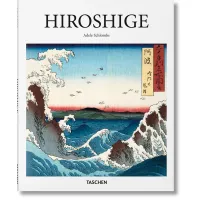Brion Gysin's book: Setting yourself up for the multimedia age - Thames and Hudson
Wonderful book editions
SKU: THANDSON-9780500284384
See other products from category Collectible books and albums about art or from manufacturer Thames and Hudson
Description
Painter, writer, sound poet, lyricist, performer - Brion Gysin first gained prominence in the 1950s in the vibrant atmosphere of the so-called Beat Hotel in Paris. His vast array of radical ideas became a source of inspiration for both the Beat Generation artists and their successors (including David Bowie, Mick Jagger, Keith Haring, and Laurie Anderson). As a painter, Gysin is remembered for his evocative views of the Sahara and unprecedented calligraphic abstractions inspired by Japanese and Arabic scripts. His later discovery of the potential of the paint roller to create an unlimited number of ready-made grids formed the basis of his unique "roller poems" from the 1970s. This concept was extended to the use of 35 mm film to create photographic sequences depicting the construction of the Centre Pompidou (Beaubourg) in Paris.
A chance observation of random word combinations by Gysin led to the development of the cut-up technique by his friend William S. Burroughs, with whom he would collaborate primarily on the production of The Third Mind (1978). Gysin's ideas also included permutated poems and the development of the Dreamachine in 1961 - "the first artwork to be viewed with closed eyes" - capable of inducing a change in consciousness in the viewer, as well as light shows and stage performances in collaboration with leading musicians such as Steve Lacy and Ramuntcho Matta. The sheer diversity of visual materials illustrated in the first comprehensive study of Gysin's life and work reveals him as a distinguished artist. Accompanying texts include a biographical outline, as well as firsthand recollections from Gysin's friends and contemporaries, such as John Giorno and Bernard Heidsieck, and analyses of his work and ideas by later scholars.
The Thames & Hudson brand was founded in 1949 by Walter and Eva Neurath. Their greatest passion and mission was to create a "museum without walls" and to make the world of art accessible to a wide audience, as well as the research of leading scholars. To reflect international perspectives, the company's name combined the rivers flowing through London and New York, represented in its logo by two dolphins symbolizing friendship and intelligence, one facing east, the other west, suggesting a connection between the Old World and the New.
Today, still an independent, family-owned business, Thames & Hudson is one of the world's leading publishers of illustrated books with over 2000 titles in print. It publishes high-quality collectible books in all areas of visual creativity: the arts (fine, applied, decorative, performing), architecture, design, photography, fashion, film, and music, as well as archaeology, history, and popular culture. The list of children's books is also expanding. With headquarters in London and a sister company in New York, and subsidiaries in Melbourne, Singapore, and Hong Kong. In Paris, another subsidiary, Interart, distributes English-language books in France.
History of the Thames & Hudson brand
Walter Neurath was born in Vienna in 1903. In 1938, he left his hometown - where he ran an art gallery and published illustrated books - for London. Initially, he worked as a production director at Adprint, a brand founded by Viennese émigré Wolfgang Foges. Neurath and Foges developed the innovative concept of what is now called book packaging (or co-edition publishing), where book ideas are developed, commissioned, produced, and sold to publishers operating in different markets and languages to create large print runs, thereby reducing unit production costs. Neurath's concept was the first of many innovations he introduced to the publishing world through Thames & Hudson.
Wishing to continue packaging collectible books in a second edition and recognizing the need to amortize the high production costs of illustrated books, Neurath founded his own publishing house, with offices in London and New York in the autumn of 1949. Eva Neurath, who had arrived in London from Berlin in 1939, was a co-founder.
Of the ten titles that were published on Thames & Hudson's first list in 1950, English Cathedrals, with photographs by Martin Hürlimann, was the first and most successful. A testament to the brand's strong belief in the longevity of books from the very beginning, it remained in print until 1971. The first year of publication also saw the release of Albert Einstein's "Out of My Later Years," an early indicator of the program's breadth. As the list gradually and successfully expanded from ten titles in 1950 to 144 in 1955, the company moved its offices from High Holborn and in 1956 relocated to a Georgian townhouse at 30 Bloomsbury Street, near Bedford Square, then the epicenter of book publishing in London. The company remained at this address, eventually expanding to five houses, until 1999, when it returned to High Holborn.
In 1958, Thames and Hudson launched one of its most renowned series, World of Art, which became a cornerstone of a very diverse list. Characterized by their pocket size and black spines, the series expanded in just seven years to include 49 titles. Nearly 60 years later, the series has featured over 300 titles, of which, according to Christopher Frayling, "there are 'paint-splattered copies' in every art school in the country."
Other important series that added depth and prestige to the list include Ancient People and Places, edited by Glyn Daniel, which since the 1950s has contributed to pioneering interest in archaeology, both in book form and on television. Over 34 titles were published in the series over 34 years. The large-format series Great Civilizations, published in 1961, included contributions from such esteemed scholars as Alan Bullock, Asa Briggs, Hugh Trevor-Roper, A. J. P. Taylor, and John Julius Norwich.
After building one of the most important publishing houses in Europe in less than two decades, Walter Neurath died in 1967 at the age of 63. Sculptor Henry Moore wrote that "his death was a loss to our cultural life." Sir Herbert Read noted that Neurath "more than any other person was responsible for the revolution in art book publishing" and was "one of those rare entrepreneurs who successfully combined business acumen with idealism." Eva Neurath became chairperson. Walter's son, Thomas, who joined the company with his sister Constance in 1961, became managing director; Constance later served as art director for several decades. Both Thomas and Constance remain on the board of Thames & Hudson, as do Thomas's daughters, Johanna and Susanna.
From producing the first commercial edition of The Book of Kells to the triumphant publication of the six-volume Vincent van Gogh - The Letters, from such technical innovations as "French folds" to the controversial documentation of graffiti art in Subway Art, Thames and Hudson has always been at the forefront, both culturally and in production techniques.
The year 2016 opened an extraordinary new chapter for the company, heralding a publishing partnership with two of the world's most important museums: the British Museum and the Victoria and Albert Museum.
The world of art and scholarship thus remains at the heart of Thames & Hudson's publishing program, which remains true to its core principle: providing a "museum without walls."
Today, Thames & Hudson is a recognizable international brand, a symbol of English publishing. Their offerings include thousands of original book titles, many of which are prestigious collector's books.
Attributes / Details
| SKU | THANDSON-9780500284384 |
| Manufacturer | Thames and Hudson |
| Model | 9780500284384 |
| Autor | Mr. Jose Ferez Kuri |
| Liczba stron | 240 |
| język | Angielski |
| Oprawa | Miękka |
| Rok wydania | 15 September 2003 |
| Size | 25.0 x 25.0 cm |
See catalog
Reviews
No reviews for this product.











